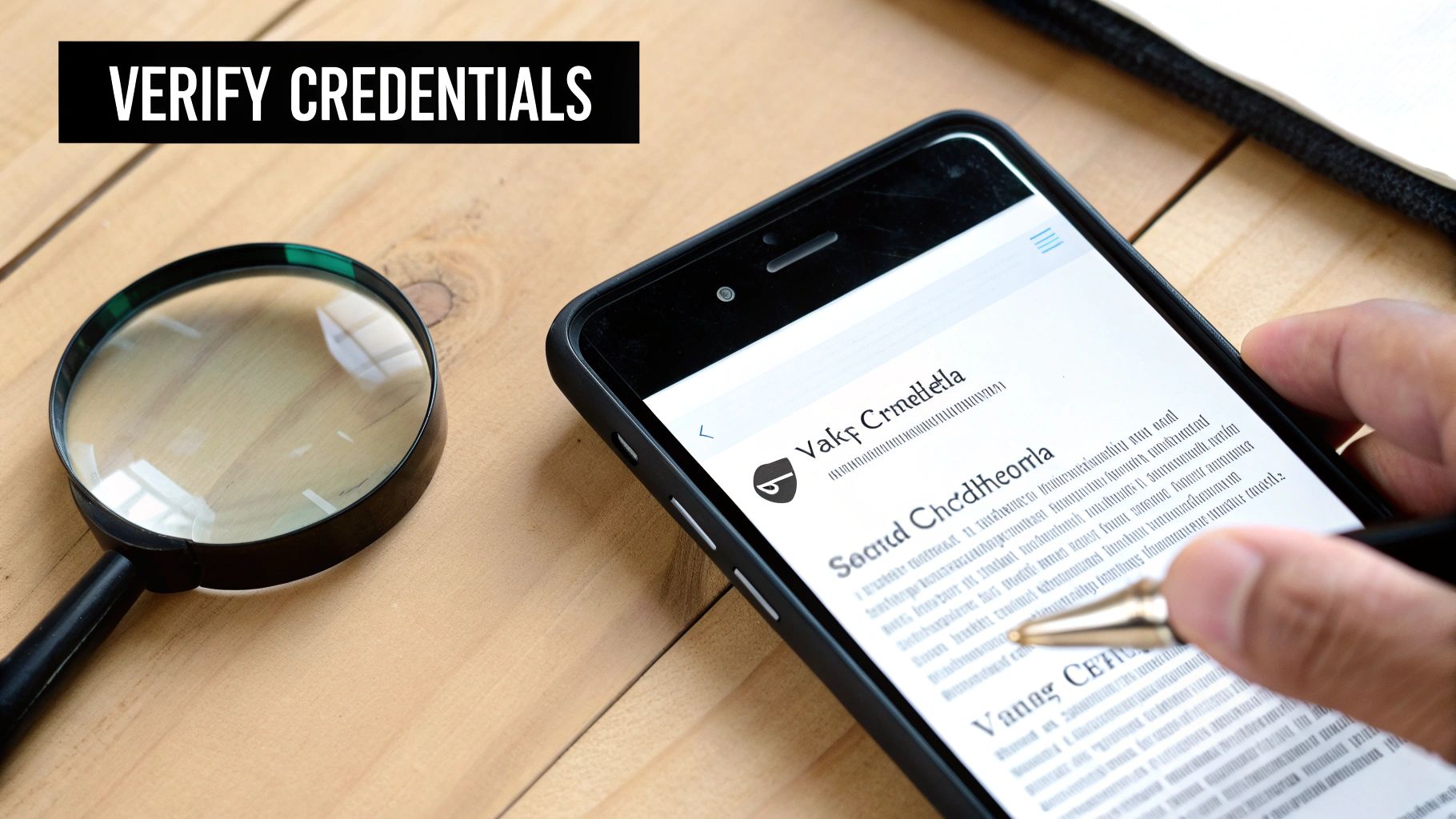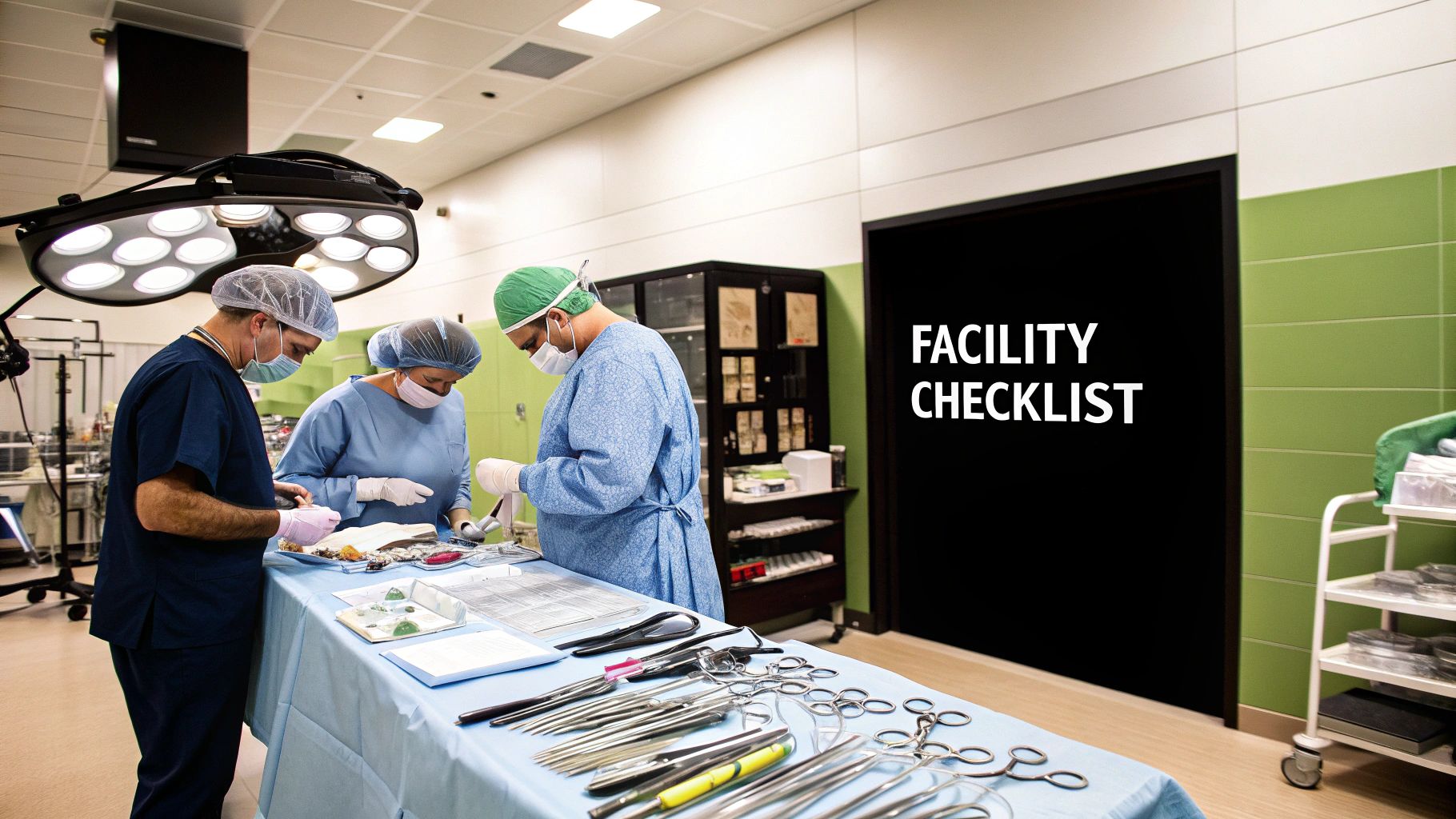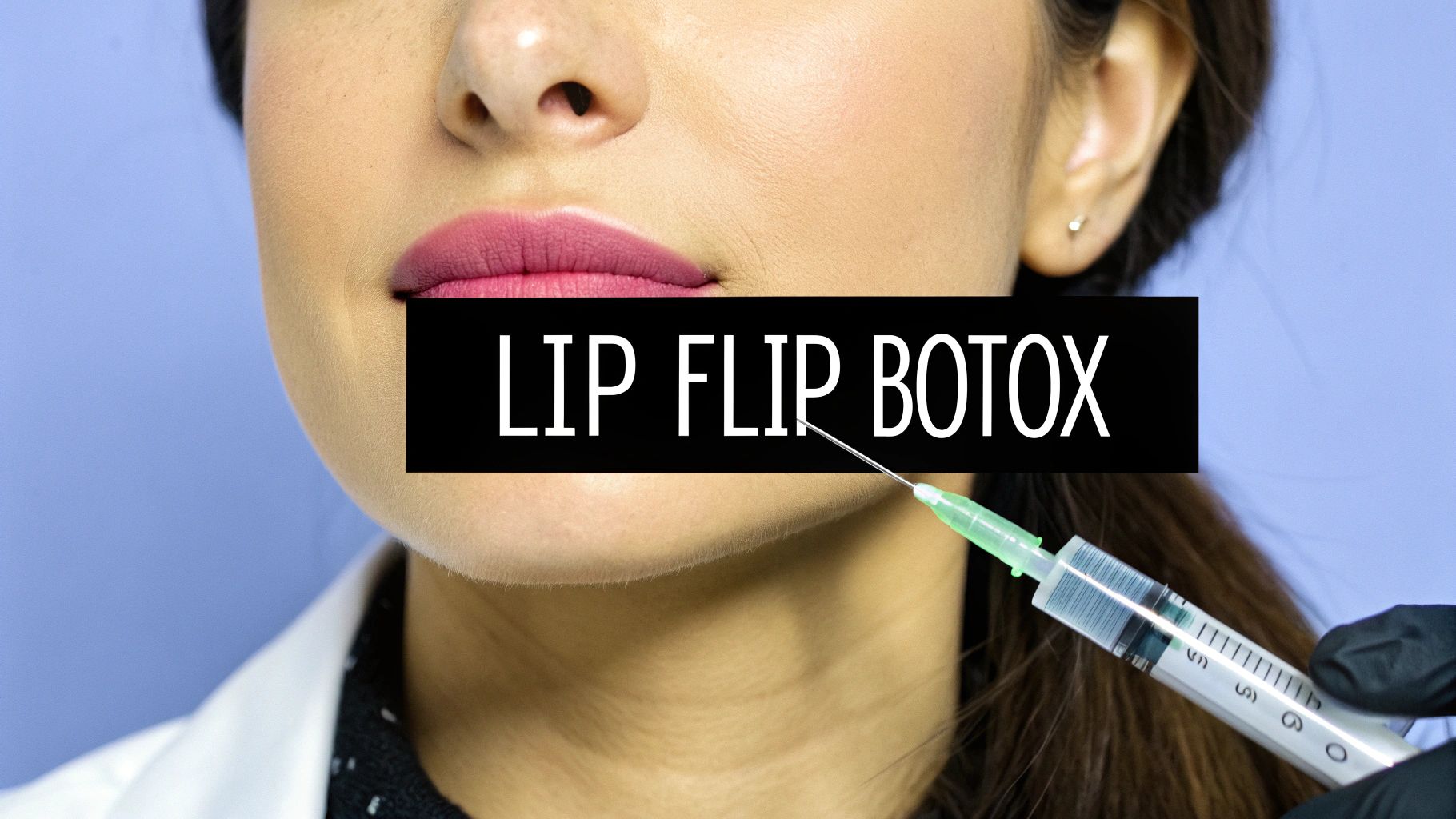
December 16, 2025
Explore coolsculpting chin fat: A guide to sharper definition
Want to tackle coolsculpting chin fat? This guide explains the procedure, pricing, downtime, and expected results to help you decide on a sharper jawline.
Oct 30, 2025

Finding the right plastic surgeon really comes down to three things: making sure they're board-certified, carefully studying their portfolio of before-and-after photos, and treating your consultation like a true two-way interview. My goal here is to give you the practical knowledge you need to feel empowered, making sure your safety and satisfaction are the top priorities right from the start.

Deciding on plastic surgery is a huge, personal step that demands careful thought and solid research. It’s so much more than just the procedure itself—it's about placing your trust, your appearance, and your health in someone else's hands. The journey doesn't begin in the operating room; it starts with building unshakeable confidence in the surgeon you choose.
The key is finding a surgeon whose expertise and artistic style match your personal goals. Are you hoping for a subtle, natural-looking refresh, or a more dramatic transformation? The surgeon who excels at one might not be the best fit for the other.
Before you do anything else, you need to get crystal clear on what you hope to achieve. This clarity will be your guide for the entire process.
Think about these points as you get started:
It's no secret that plastic surgery is more common than ever. Globally, surgeons performed around 38 million procedures in a recent year—that's a 42.5% jump in just four years. With so many options out there, this boom just underscores how crucial it is to make a well-informed decision. You can discover more insights about these global plastic surgery statistics and see what the trends mean for patients like you.
Your relationship with your plastic surgeon is a partnership. The ideal surgeon is not only technically skilled but also an attentive listener who understands your vision and respects your concerns. Trust and clear communication are non-negotiable.
With a clear vision of your goals, it's time to start putting together a list of potential surgeons. Don't get bogged down in the details just yet; this is about casting a wide, informed net.
Begin by looking for local surgeons who specialize in the procedure you're interested in. A fantastic place to start is the website for a professional organization like the American Society of Plastic Surgeons (ASPS). Their directories are filled with board-certified members, giving you a pre-vetted list to begin your search.
To make this initial phase a bit more manageable, I've put together a quick checklist to guide your first steps.
Think of this table as your starting game plan. It covers the absolute essentials for building a solid foundation for your search.
Following these initial steps will help you narrow down the field efficiently, ensuring that you only spend time and energy on surgeons who are genuinely qualified and aligned with your aesthetic vision.

Alright, you've got a shortlist of potential surgeons. Now comes the most critical step of all: doing your homework on their qualifications. This is where you separate the genuine experts from the rest.
Here’s a startling fact that many people don't realize: any licensed medical doctor can legally call themselves a "cosmetic surgeon" and perform procedures. That means a doctor with a background in an entirely different field could take a weekend course on liposuction and start advertising their services.
Because that title isn't regulated, the responsibility falls on you to dig deeper.
What you're really looking for is a board-certified plastic surgeon. This isn't just a fancy title. It means they've gone through a highly specialized and grueling training path focused exclusively on plastic and reconstructive surgery.
So, what’s the big deal about being certified by the American Board of Plastic Surgery (ABPS)? It’s a rigorous standard that goes far beyond just having a medical license.
This isn't just a piece of paper they hang on the wall. Earning that certification is a serious commitment. It means the surgeon has:
You might also see the term "board-eligible," which can be a bit confusing. It’s worth taking a moment to understand the key differences between a board-eligible vs. board-certified surgeon to see why one offers more assurance than the other.
The best part is, you don't have to take their website's word for it. You can—and absolutely should—verify their credentials yourself. It only takes a few minutes.
Head over to the American Board of Plastic Surgery website. They have a simple lookup tool where you can enter the surgeon’s name and see their status for yourself. A surgeon certified by the ABPS is a true specialist in surgery for the entire body.
Board certification is the gold standard for a reason. It's an objective, verifiable measure of a surgeon's training, knowledge, and commitment to patient safety. Never let a flashy office or slick marketing campaign substitute for this fundamental credential.
While board certification is non-negotiable, a few other things can give you an extra layer of confidence in your choice. Think of these as additional signs that you’re in good hands.
Hospital Admitting Privileges
This is a big one. Ask if your surgeon has hospital admitting privileges. This means a local hospital has reviewed their qualifications and trusts them enough to admit and treat patients there.
If a surgeon only operates out of their private facility and doesn't have privileges at a nearby hospital, it could be a red flag. Why? It might suggest they don't meet the hospital's strict credentialing standards. In the rare event of a complication, having hospital privileges ensures you can be transferred and cared for seamlessly.
Professional Society Memberships
Finally, see if they belong to respected professional organizations. Being part of these groups shows a surgeon is actively engaged in their field and committed to ongoing education. The two most prestigious are:
These memberships are another strong signal that you're dealing with a dedicated professional who stays current on the latest techniques and safety protocols.

Once you've narrowed down your list to a few board-certified specialists, the real detective work begins. It’s time to move past credentials and start evaluating their actual surgical results. Think of yourself as an art critic, because a surgeon's before-and-after gallery is their portfolio. It’s a direct window into their skill, consistency, and aesthetic style.
Your goal here isn't just to find "good" results, but to find results that truly resonate with your personal vision. Are you hoping for an outcome so natural no one will know you had work done? Or are you aiming for a more defined, dramatic change? Scrutinizing a surgeon's past work is the only way to know if their artistic eye aligns with yours.
The most helpful photos in any gallery are those of patients who started out looking a lot like you. Don't just browse randomly. If you're considering a rhinoplasty to address a prominent dorsal hump, hunt for examples of how the surgeon has handled that specific issue. If you’re looking into breast augmentation, find patients with a similar body frame and starting breast volume.
This targeted approach is crucial for a few reasons:
You're essentially looking for proof that the surgeon has successfully helped people in your exact situation achieve the kind of results you're after. To get even better at this, check out this guide on https://www.ccplasticsurgery.com/blog/before-and-after-photos-plastic-surgery for tips on what to look for.
A robust photo gallery speaks volumes about a surgeon's confidence and transparency. When they proudly display a wide variety of cases—not just the straightforward ones—it shows a breadth of experience and a commitment to real-world results.
A surgeon’s portfolio shows you the "what"—the final surgical outcome. But patient reviews reveal the "how"—the entire experience from the first call to the final follow-up. This is where you uncover the critical parts of patient care that photos can never show.
When you start digging into testimonials, look for patterns. A single glowing review or one terrible one doesn't tell the whole story. What you're really looking for is the overall sentiment across multiple platforms.
Pay close attention to comments about:
Platforms like general review sites like Yelp are great for this, as they often have very candid, unsolicited feedback that can be incredibly revealing about a practice's daily operations.
Not all reviews are created equal. Your job is to sift through them to find the authentic, detailed accounts that offer genuine insight. A generic "Dr. Smith is great!" review is nice, but it's not very useful.
What you want are reviews that mention specifics. For instance, a patient who shares that the surgeon personally called them the evening after their surgery gives you a powerful glimpse into their standard of care. On the other hand, if you see multiple reviews complaining about long wait times or rushed appointments, it might be a red flag that the practice is overbooked.
It's also interesting to see how aesthetic preferences vary globally. Countries like Brazil and Japan are major players, but with different focuses. Brazil is a leader in surgical procedures like breast implants and liposuction. Japan, ranking third globally, has a huge market for a wide range of cosmetic treatments. The entire Asia Pacific region is seeing massive growth, with Japan's market projected to hit USD 2.20 billion by 2025.
Ultimately, you build a complete picture by combining a critical eye for a surgeon’s portfolio with a thoughtful analysis of patient feedback. This two-pronged approach is the best way to assess both their technical skill as a surgeon and their commitment to providing an exceptional patient experience from start to finish.
https://www.youtube.com/embed/nfcriVAILfs
The consultation is, without a doubt, the most critical meeting you'll have on this journey. It’s so much more than just a quick chat to get a price quote. Think of it as a two-way interview: you're vetting their expertise and character, and they're determining if you're a safe and suitable candidate for the procedure.
This is your moment to transform a standard appointment into a genuine conversation. You’ve already done the hard work of checking credentials and looking at before-and-after photos. Now, you get to see the human side of things—how they listen, how they explain complex ideas, and whether you feel a real connection. A great consultation should leave you feeling informed and confident, not rushed or confused.
Walking into this meeting without a plan is a huge missed opportunity. While the surgeon will lead the discussion, the questions you bring are what will truly uncover the details that matter for your safety and happiness with the final result.
You need to go deeper than just asking, "How much will it cost?" It’s time to dig into the specifics that reveal their hands-on experience and their unique approach. To get a better feel for the flow of the appointment, it's a good idea to understand what happens during a plastic surgery consultation before you even walk in the door.
Organizing your questions by category is a smart way to make sure you cover everything. Here’s a good starting point:
These kinds of questions give you a much clearer picture of their standards and how they care for their patients when it really counts.
To make this even easier, I've put together a checklist of questions you can bring with you. This will help you stay organized and ensure you don't forget anything important in the moment.
Having these questions ready will empower you to lead a more meaningful conversation and get the clarity you need to make the best decision for yourself.
A surgeon’s technical skill is non-negotiable, but their bedside manner is equally vital. You are about to enter a significant partnership, and you need a partner who truly listens to your goals and can explain everything—the good and the bad—in a way that makes sense to you.
During the consultation, pay close attention to the vibe. Do they make good eye contact and give you their undivided attention, or do they seem distracted and in a hurry to get to the next patient? A surgeon who is a true professional will never make you feel like your questions are trivial or that you're an inconvenience. They should be patient, empathetic, and genuinely focused on understanding your vision.
A surgeon who dismisses your concerns or tries to push their own aesthetic preferences onto you is a massive red flag. The right surgeon is an expert guide, collaborating with you to create a surgical plan that honors your unique goals.
While you're looking for all the green lights, you absolutely must be on the lookout for warning signs. Trust your gut in this process. If a situation or a person feels off, it probably is.
Be ready to walk away from any practice that demonstrates these behaviors:
Spotting these red flags can save you from a world of regret. A reputable surgeon always puts your long-term well-being first—not just the bottom line. This consultation is where their true commitment to patient safety and satisfaction really shines through.

A surgeon’s skill is essential, but they never work alone. The quality of their operating facility and the caliber of their support staff are just as critical to your safety and your overall experience. A top-tier surgeon operating in a second-rate environment is a red flag you can't afford to ignore.
Think of it this way: you're not just choosing a surgeon; you're choosing an entire ecosystem of care. From your first phone call to your last follow-up, every detail matters. A well-run, professional, and genuinely caring environment shows a surgeon’s deep commitment to excellence across the board.
If your procedure will happen in a private surgical suite at the surgeon’s office—not a hospital—then accreditation is non-negotiable. This is your guarantee that an independent organization has thoroughly inspected the facility and verified that it meets strict national standards for patient safety, equipment, and staff qualifications.
Accreditation is for a facility what board certification is for a surgeon. It's proof that the operating room is fully equipped to handle your procedure and any potential emergencies, just like a hospital.
Keep an eye out for these three primary accrediting bodies:
Don't be shy about asking the office staff about their accreditation. Any reputable practice will be proud to tell you all about it.
Two other key players have a massive impact on your procedure: the anesthesiologist and the nursing team. Their expertise is what keeps you safe and comfortable before, during, and after your surgery.
Your surgeon should only work with a board-certified anesthesiologist or a Certified Registered Nurse Anesthetist (CRNA). These are highly trained medical professionals who specialize in administering anesthesia and monitoring your vitals from start to finish. This is not a job for a general nurse; it demands specific, advanced skills to ensure your safety while you're asleep.
The nursing staff is just as important. They are your primary caregivers during your immediate recovery. A skilled and compassionate nursing team makes all the difference, managing your comfort and watching for any potential issues right after surgery.
Your surgical team is so much more than just your surgeon. A board-certified anesthesiologist and a dedicated, experienced nursing staff are essential for a safe outcome. This support system is a direct reflection of the surgeon's own high standards.
Your evaluation starts the moment you pick up the phone or step into the office. Pay close attention to the vibe of the place and how you're treated in every interaction.
Here’s what to look for:
At the end of the day, you are entrusting your well-being to an entire team. A surgeon who surrounds themselves with a top-notch staff and operates in an accredited, first-class facility is showing you they are serious about your safety and getting you the best possible result.
You’ve done the hard work. You’ve checked credentials, looked at hundreds of before-and-after photos, and had some really in-depth consultations. Now comes the final, and frankly, the most personal part of the journey: choosing the surgeon who feels right.
This isn't just about picking the doctor with the flashiest credentials or the cheapest quote. It’s about putting all the pieces together—from their board certification to their artistic eye—and adding in that crucial human element. Trust and rapport are just as vital as technical skill.
To make this final step less overwhelming, it helps to get everything down on paper. Lay out the objective facts for your top two or three surgeons side-by-side. This simple act can cut through the noise and help you focus on what really matters.
Try creating a simple chart or even just a list for each candidate covering these key areas:
This structured approach keeps one amazing quality from overshadowing a potential red flag. For instance, a surgeon might have a stunning portfolio, but if your consultation felt rushed and impersonal, that's a huge piece of the puzzle. As you weigh these factors, remember that a surgeon's digital presence often reflects their real-world practice; understanding the importance of online reputation can either validate or challenge your feelings of trust.
Your intuition is a powerful tool here. Once you've laid out all the logical pros and cons, step back and listen to that inner voice. If one surgeon simply made you feel more seen, heard, and secure, that gut feeling is worth its weight in gold.
After all the research and analysis, this decision often boils down to trust. You aren't just hiring a service provider; you are choosing a partner for a deeply personal experience. The right surgeon is someone you feel completely comfortable with, someone you believe truly has your best interests at heart.
Think back to your interactions. Did one surgeon take extra time to patiently explain the recovery process? Did one office team make you feel like a valued person rather than just another appointment on the schedule? These subtle differences in care and communication are often a preview of the entire experience to come.
Ultimately, your choice is about finding the surgeon who not only checks every professional box but also gives you that profound sense of confidence, allowing you to walk into your procedure feeling positive and secure.
At Cape Cod Plastic Surgery, we believe that confidence is built on a foundation of trust, expertise, and personalized care. Dr. Marc Fater and our team are dedicated to guiding you through every step of your journey with transparency and compassion. Learn more about our approach and schedule your consultation today.

December 16, 2025
Want to tackle coolsculpting chin fat? This guide explains the procedure, pricing, downtime, and expected results to help you decide on a sharper jawline.

December 16, 2025
Ensuring Patient Safety Through Rigorous Accreditation on Cape Cod

December 15, 2025
Considering a subtle enhancement? Learn what is lip flip botox, how it differs from fillers, the costs involved, and what the procedure is really like.